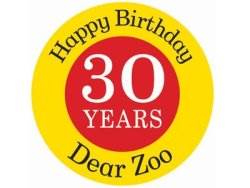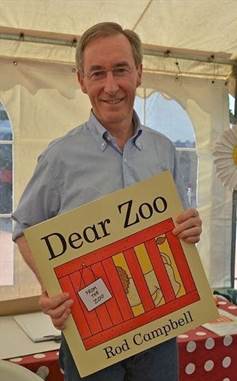Rod Campbell: Happy Birthday Dear Zoo!
Published on: 8 Awst 2012 Author: Rod Campbell
To celebrate the 30th birthday (2012) of the classic lift-the-flap book Dear Zoo, we spoke to its award-winning creator Rod Campell about how he creates his wonderful children's books.

How did the idea for Dear Zoo first come about?
New to children's books, I saw a flap book (rare at the time) and realised how important they could be to pre-readers and decided to do one myself. The revealing of animals by flaps seemed a good device to interest the child, but then it was a question of how to build a story around it. The only way for the flaps to make sense was to use them as crates and boxes with an animal inside, which led to the idea of animals being sent somewhere. The final idea came to me 'whole' - that is to say I knew exactly what to do and how to do it.
Can you believe that the book marked its 30th anniversary in 2012? Did you ever expect it would be so enduringly popular – and what do you think is the secret to its success?
It's hard to believe so many years have passed since it was published, let alone that it is almost more popular now than when it came out!
One 'makes' a book from an idea, text and illustrations the best way one can, and then it's published and it has a life of it's own. I had no idea that it would endure, but am naturally delighted that it has. Perhaps it's longevity is the consequence of the right mix of idea and execution. The flaps demand participation and the revealing of the animals (even when the child knows what lies behind), delights young children. The simplicity and logic of the story makes sense to them, and ending on an upbeat note brings the experience to a satisfactory conclusion!
 Dear Zoo is one of the most popular books on the Bookstart website. What do you think makes a picture book work particularly well for parents and children to read and enjoy together?
Dear Zoo is one of the most popular books on the Bookstart website. What do you think makes a picture book work particularly well for parents and children to read and enjoy together?
Well, I think first of all the story has to be appropriate to the child's age and experience. The text should be easy to read and the pictures should amplify the text and be in tune with it. For the very young, I believe in a short text with some repetition so the child can join in and believe they are 'reading' too. Being able to say the words and know what they mean is the first step to reading in my view.
The story must make sense to the young 'reader' and it should come to a satisfactory ending, either by an understandable and appropriate resolution, or on a completely logical upbeat note.
As well as Dear Zoo, you're also the creator of lots of other books, including Counting Bugs, I Won't Bite, and of course the Buster series. Do you have a favourite amongst all the books you've written and illustrated?
Apart from the books you mention, I am happy to say that very many of my books are still in print. No, I don't have a favourite as they are all different - if you have lots of children it's hard to choose amongst them!
How do you create the artwork for your books?
I make a pencil rough which is refined then drawn in pencil onto the paper I will use for the finished artwork. I then draw the outline with a black permanent ink pen and rub out any traces of pencil around it. Now it's colouring in time! I use liquid watercolours and fill in the areas with pure colour. The final stage is to give shading and texture by using felt pens. There - all my secrets revealed!
Who are your favourite picture book creators? Which other authors and illustrators have influenced your work?
Eric Hill and his creation Spot introduced flaps to modern children's books in the UK and influenced many of us, as did Eric Carle's The Very Hungry Caterpillar where suddenly pages of different size, and even holes could be used to great effect in a book. As a 'maker' of books for the very young (rather then an author or illustrator), these new possibilities were inspiring and stimulating, and I have used them (and others) to make books that will draw young children to books and ultimately reading.
What are you working on next?
I have one or two ideas rolling around my head so I'll have to wait and see!






Add a comment